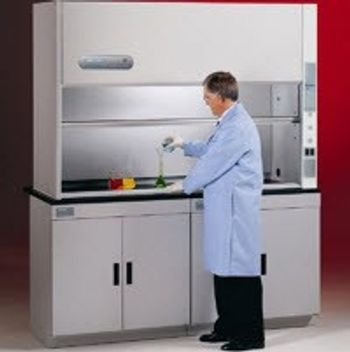
Purchasing the correct Fume Hood for your laboratory is a very important, long-term decision and your choice in lab ventilation systems will affect future lab planning, flexibility and safety. There are three main questions you should ask before proceeding through this guide: What level of protection will the lab worker require? What is the face velocity needed for the experiment? What materials are going to be used under the hood? You should also take into consideration the space you have available for the fume hood. This guide will introduce the four main fume hood types available. Read about each one and then proceed to the appropriate sub categories where you will find an unbiased list of all the models from all manufacturers that may suit your needs.
Ducted Fume Hoods
Ducted Fume Hoods in the past were the only option available to labs and account for only one  component of a total lab ventilation system, which includes a series of ducts, blowers and filters running through the entire building. However, choosing the right fume hood enclosure for inside your lab space is very important.
component of a total lab ventilation system, which includes a series of ducts, blowers and filters running through the entire building. However, choosing the right fume hood enclosure for inside your lab space is very important.
Conventional Ducted Fume Hoods often describes the traditional, less elaborate fume hoods that have a constant air volume. Face velocity is inversely proportional to the sash height unless a by-pass is in place. The by-pass helps direct airflow and reduces the increase in face velocity as the sash closes. The by-pass enables the hood to have a more constant volume of exhaust air. This provides general protection to the lab worker.
View all Conventional Ducted Fume Hoods
Variable Air Volume Ducted Fume Hoods maintain a constant face velocity regardless of the sash position by employing a closed loop system that is constantly measuring and adjusting the amount of air being exhausted. In many hoods, inaccurate face velocities will sound audible and visual alarms, which in addition to the constant face velocity, greatly increase the protection of the lab worker. This also reduces the total volume of supply and exhaust air needed, which in turn lowers total energy costs.
View all Variable Air Volume Ducted Fume Hoods
Canopy Ducted Fume Hoods are typically used when the area that needs ventilation is too large to fit inside a regular hood. They are suspended above the work area. The lab worker is not protected well, as the fumes are often drawn right across the user’s breathing zone.
View all Canopy Ducted Fume Hoods
Ductless Fume Hoods
Ductless Fume Hoods are single enclosed units that require no duct work or fixed installation. They remove fumes, vapors and particles from both the experiment and the lab worker by filtering them through a combination of HEPA and carbon filters and exhausting them safely back into the lab air.
Benchtop Ductless Fume Hoods offer a very convenient alternative to traditional ducted fume hoods as they can be placed on rolling carts and moved around the lab as required, or permanently mounted to a bench.The lab worker is protected as the fumes are drawn back, up and away while clean air is recirculated back into the lab after being filtered.
View all Benchtop Ductless Fume Hoods
Free-Standing Ductless Fume Hoods allow for applications that involve added vertical height, which cannot be found when using benchtop hoods.The lab worker is protected as the fumes are drawn back, up and away while clean air is recirculated back into the lab after being filtered.
View all Free-Standing Ductless Fume Hoods
Down Flow Workstations direct air in the opposite direction as most other hoods; they push it down. The air containing powders or chemicals with high molecular weights are swept into the base of the workstation, protecting the lab worker by removing it away from their breathing zone.
View all Down Flow Workstations
Portable Ductless Fume Hoods are designed to go anywhere science takes you in the field or for temporary hood needs in the lab.The lab worker is protected as the fumes are drawn back, up and away while clean air is recirculated back into the environment after being filtered.
View all Portable Ductless Fume Hoods
Laminar Flow Hoods
Laminar Flow Hoods provide clean air via a HEPA filter to the lab bench space and a constant air flow out of the work area, which prevents surrounding room air from entering. The air flowing out of the hood also suspends and removes contaminants and particles creating clean air spaces.
Horizontal Laminar Flow Hoods bring in external air through a pre-filter, and HEPA filter then push it in horizontal lines outward from the back of the hood workspace. While this protects the samples
from particle contamination, these hoods are not intended to protect the lab worker.
Vertical Laminar Flow Hoods move air down from the top of the unit in a vertical line through a HEPA filter to the bottom intake. A blower then pushes the air back up to a HEPA filter exhaust. While this protects the samples from particle contamination, these hoods are not intended to protect the lab worker.
View all Laminar Flow Hoods
PCR Enclosures
PCR Enclosures are designed specifically to provide a Class 5 work space for PCR experiments by moving HEPA filtered air downward. What makes them unique is a UV light that eliminates DNA and RNA contaminants.
View all PCR Enclosures
